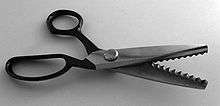Pinking shears
Pinking shears are scissors, the blades of which are sawtoothed instead of straight. They leave a zigzag pattern instead of a straight edge.

The pinking shears design was patented by Louise Austin in 1893.[1] In 1934, Samuel Briskman patented a pinking shear design (Felix Wyner and Edward Schulz listed as the inventors).[2] In 1952, Benjamin Luscalzo was granted a patent for pinking shears that would keep the blades aligned to prevent wear. [3]
Pinking shears have a utilitarian function for cutting woven cloth. Cloth edges that are unfinished will easily fray, the weave becoming undone and threads pulling out easily. The sawtooth pattern does not prevent the fraying but limits the length of the frayed thread and thus minimizes damage.[4]
These scissors can also be used for decorative cuts and a number of patterns (arches, sawtooth of different aspect ratios, or asymmetric teeth) are available. True dressmaker's pinking shears, however, should not be used for paper decoration because paper dulls the cutting edge.
Etymology
_Dianthus_plumarius_-%E4%B8%8A%E6%B5%B7%E6%A4%8D%E7%89%A9%E5%9C%92_Shanghai_Botanical_Garden-_(9180634129).jpg)
The cut produced by pinking shears may have been derived from the garden plant called the pink, in the genus Dianthus (the carnations).[5] The color pink also may have been named after these flowers, although the origins of the name are not definitively known. As the pink has scalloped, or "pinked", edges to its petals, pinking shears can be thought to produce an edge similar to the flower.
The word "pink" can be used as a verb dating back to 1300 meaning "pierce, stab, make holes in".
References
- Austin, Louise. "Pinking Shears patent". Google patents. Google. Retrieved October 1, 2019.
- Wyner, Felix (July 3, 1934). "Pinking Shears Patent". Google Patents. Retrieved December 8, 2019.
- , "Pinking shears", issued 1948-10-04
- Hinze, H. (April 1916). "The Pinking Machine -- Its Uses". The Clothing Designer and Manufacturer. 9 (1): 41.
- Pankiewicz, Philip R. (2013). American Scissors and Shears. Universal-Publishers.